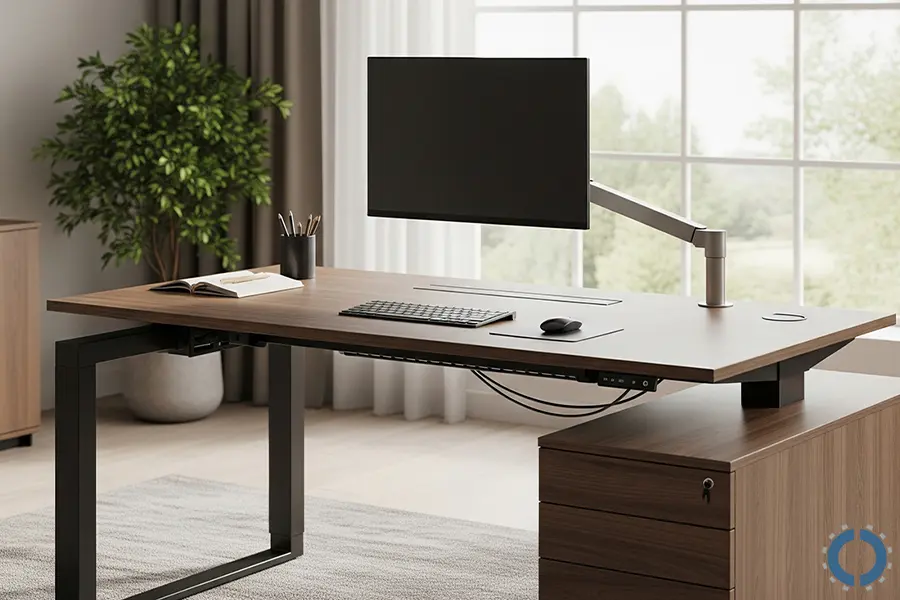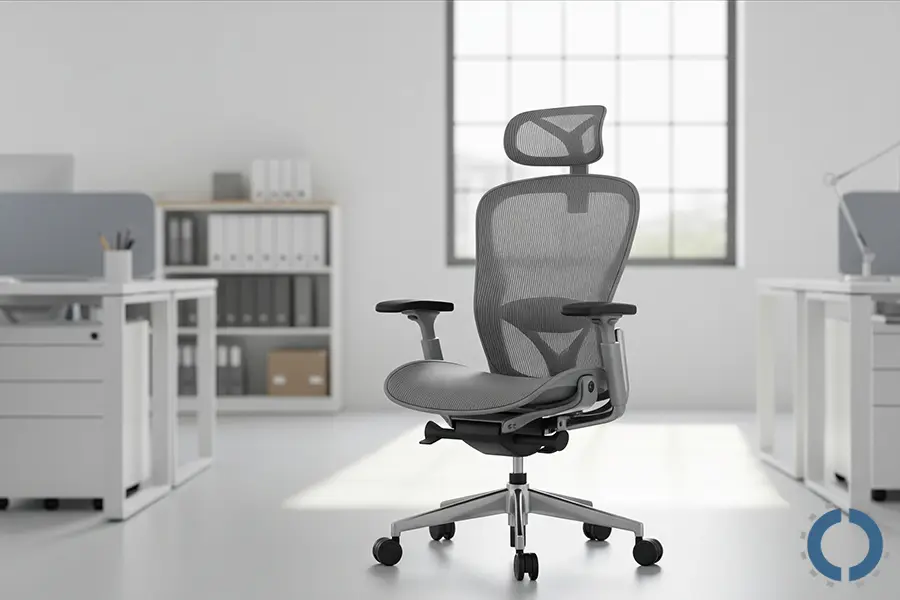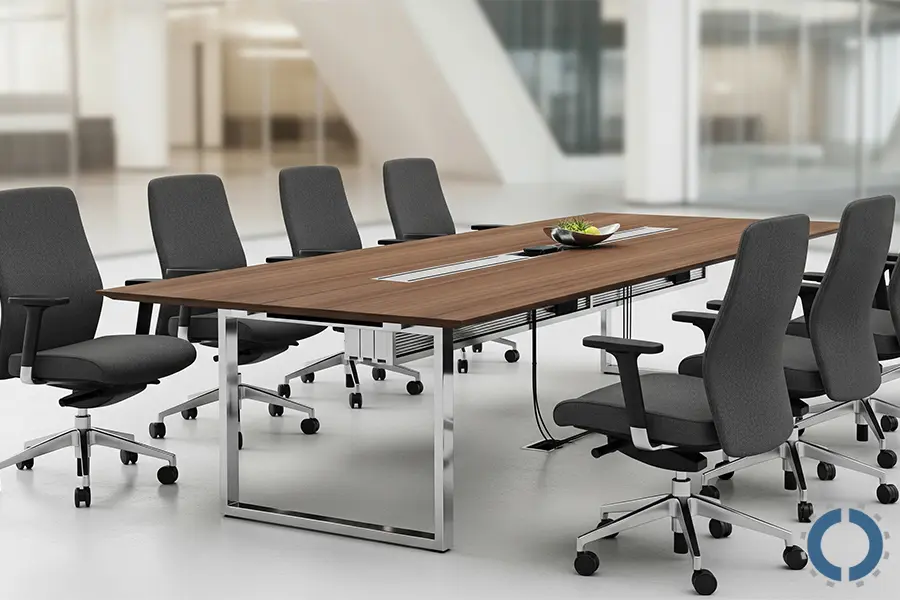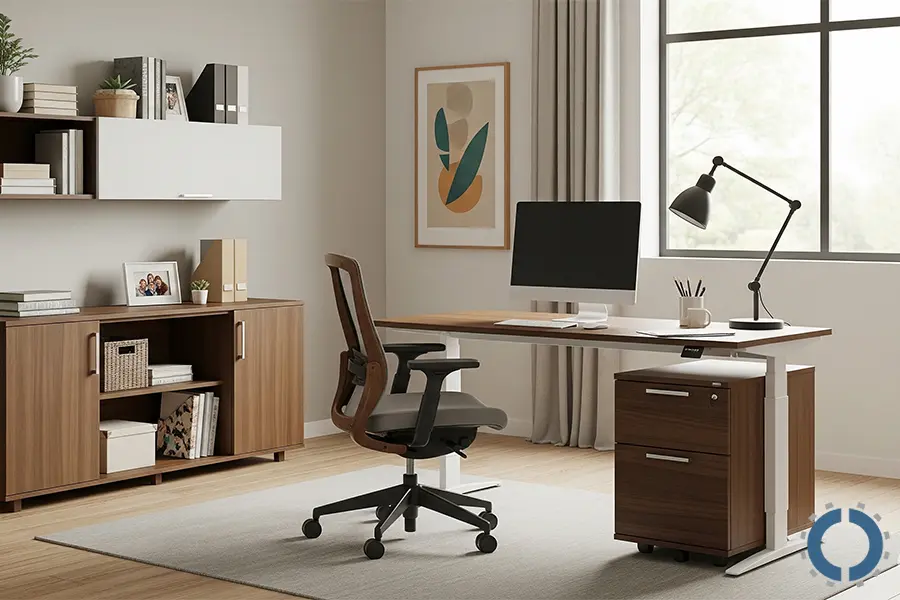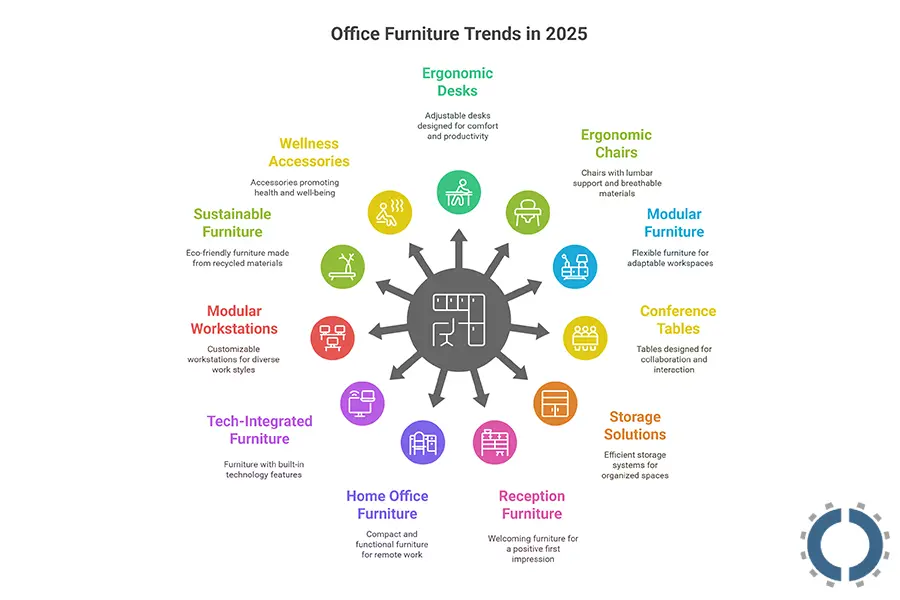Top 11 Essential Types of Office Furniture You Need in 2025
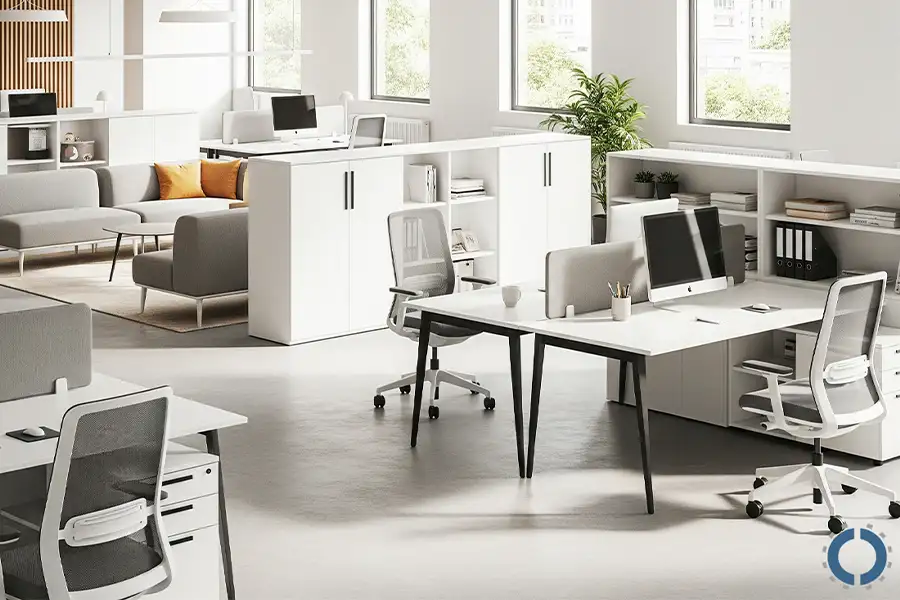
As 2025 begins, significant changes are taking place in Houston’s workplaces to meet the new needs of employees and businesses.
If you are a business owner in Houston and are looking to design or redesign your office, you have probably wondered: What types of furniture can provide a modern, comfortable environment that is compatible with today’s business needs in 2025?
The answer lies in choosing the right furniture.
Modern business environments benefit from ergonomic seating, height-adjustable desks, and modular furniture that supports flexibility and collaboration.
Look for comfortable lounges and collaborative tables, integrated storage solutions, and accent pieces that enhance the overall aesthetic while promoting employee well-being and productivity.
In this article, we will address exactly these topics and introduce you to 11 of the most important and newest types of office furniture Houston that you must know about in 2025.
Why Office Furniture Is No Longer Just Furniture
Choosing the right office furniture not only gives the workplace a modern and professional look but can also play an effective role in promoting productivity, creativity, employee health, and the company’s economic growth.
Being aware of the types of office furniture and choosing the right options helps create an efficient and pleasant space and supports the work team in achieving organizational goals.
Also, environmental approaches are becoming more important than ever in 2025, and sustainable and eco-friendly office furniture has become a popular choice among businesses.
In this article, we will address exactly these topics and introduce you to 11 of the most important and newest types of office furniture that you must know about in 2025.
This list will help you create a workspace that increases productivity, maintains employee health, and projects a professional image of your brand.
Top 11 Types of Office Furniture in 2025
1. Ergonomic Desks
In 2025, good office desks and tables should align with the physical needs of the application, current technologies, and modern work styles.
One of the most important types of office furniture that has a great impact on the productivity and comfort of employees is ergonomic desks.
Ergonomic desks are designed to fit the user’s exact needs, not only helping to reduce fatigue and musculoskeletal injuries but also allowing employees to remain comfortable and productive in a variety of body positions and work environments.
- Sit–Stand Desks: Standing desks are known as one of the most popular office furniture options in the modern workplace.
These types of office desks encourage variety in posture.
Alternating between sitting and standing throughout the day reduces static stress on muscles, improves blood circulation, and thus reduces feelings of fatigue and possible metabolic problems.
A standing desk helps prevent neck and back problems by helping to change posture and reduce pressure on the spine.
Another important point is that, according to research, standing throughout the day can play an effective role in reducing the risk of diseases such as type 2 diabetes and heart problems.
- Collaborative Desks: As an innovation in modern office furniture, hexagonally designed collaboration desks are of particular importance in improving the team workspace.
One of the biggest advantages of these tables is their flexible layout; several tables can be connected together to create different spaces for group work or small meetings.
Additionally, collaboration desks are very practical and easy to use because they are modular.
Desks can be easily added or removed without requiring major changes to the office’s decor or structure.
On the other hand, these types of desks are great for strengthening team communication and making the workspace more efficient.
- Smart Desks: One type of office furniture you must know in 2025 is smart desks.
Smart Desks are a new generation of office furniture that combines technology and ergonomics to provide a different experience of working at a desk.
One of the most important features of this type of office furniture is the ability to adjust its height electronically.
This feature allows the user to effortlessly change the height of the desk and easily switch between sitting and standing positions with just the press of a button.
Another useful feature of these tables is their ability to connect to mobile or computer applications.
This feature allows remote control via Bluetooth.
Smart desks are usually equipped with other technological features, including USB ports, wireless chargers, cable management systems, and even sensors to monitor the user’s sitting or standing position.
2. Ergonomic Office Chairs
The other types of furniture that are popular in 2025 are ergonomic office chairs.
Office seating designed in 2025 will play a significant role in improving the health and comfort of employees, while also helping to increase their productivity.
These chairs should meet the needs of employees in the workplace and provide them with a comfortable space.
For this reason, the features we will examine below are included in modern office chairs.
- Lumber Support: Advanced ergonomic chairs have adjustable lumbar support.
This back support maintains the natural curvature of the spine, reduces pressure on the lumbar discs, and prevents chronic pain.
- Depth Adjustment: The ability to adjust the seat depth helps to ensure the proper distance between the edge of the seat and the back of the knee, ensuring better blood circulation.
Also, intelligent height adjustment is essential for proper thigh alignment with the ground.
- Breathable Materials: Using mesh or breathable fabrics such as mesh causes air flow and prevents the accumulation of heat and sweat, which increases comfort and concentration during the day.
Ergonomic office chairs have numerous benefits that directly affect people’s physical health and work quality.
One of their most important benefits is maintaining spinal alignment and back health.
On the other hand, the design of these chairs is such that it increases the user’s comfort and concentration during long working hours.
Extensive customization capabilities, including height adjustment, backrest angle, seat depth, and armrest position, allow each person to customize the chair to their needs and body shape.
3. Modular and Collaborative Furniture
In the modern office of 2025, work environments must quickly adapt to the needs of the team and the organization.
For this reason, using modular and flexible types of office furniture prepares the workplace for organizational growth.
- Moveable Partitions: Modular partitions and demountable walls provide businesses with the ability to divide space without the need to build or tear down solid walls.
This equipment, sometimes a combination of storage shelves or acoustic panels, is considered a more economical, faster, and more sustainable solution than structural changes to office space.
- Hot‑Desking Layouts: By providing shared desks for employees in a hybrid workspace, the hot-desking system prevents wasted space and ensures the best utilization of the environment under changing work needs.
Equipping such spaces with modular furniture makes workflow easier to manage and increases interaction between people.
- Pods, Booths, and Acoustic Furniture: Acoustic pods or prefabricated private spaces with easy-to-move features, sound insulation, and independent ventilation allow for phone conversations or individual work concentration in an open space.
With the rise in popularity of these private pods following the experience of working remotely and the need for sound privacy, they have become an essential tool in office design.
- Modular Cabinets and Storage: For growing offices, storage systems can be very useful and helpful.
These systems include shelves, drawers, cabinets, and combination units that can be expanded or moved without having to buy new furniture or change the office structure.
Their vertical, sliding, or movable usability optimizes usable office space.
4. Conference and Meeting Tables
Conference or meeting tables are designed to bring people together in the workplace, and their main purpose is to create an environment that facilitates collaboration and interaction between teams.
In the past, conference tables were mainly designed in a rectangular and long shape, but in recent years, especially in 2025, these designs have shifted towards more creative and interactive styles.
One such example is hexagon tables, which help create an open, non-hierarchical conversation space by providing equal viewing angles for all participants.
There has also been an increase in the use of round or U-shaped tables, which foster a sense of participation, equality, and face-to-face interaction in meetings.
This evolution in designs has a practical aspect and represents a change in attitude towards organizational culture and the role of collaboration in the modern workplace.
New desks are often made with a modern design, minimalist colors of gray, white, matte black, and soft edges.
5. Storage Solutions
In a modern office, storage solutions are types of office furniture that play a vital role in maintaining order, productivity, and optimal use of space.
- Vertical storage: Various types of storage equipment are designed for various purposes, including vertical and horizontal filing cabinets.
Vertical models are usually narrow and tall, making them suitable for small spaces, while horizontal models have wider drawers and provide quicker access to documents.
- Credenzas: Credenzas are also a type of cabinet or side table that, in addition to storage, has a decorative aspect and is often used in management spaces or meeting rooms.
- Smart storage integration: In 2025, there is a lot of focus on smart storage integration.
This means using hidden spaces, digital locking systems, and even lockers with the ability to charge devices or securely store digital items.
- Shelving and bookcase: Shelving Units are also used to categorize books, folders, or frequently used office supplies, allowing the user quick and easy access.
6. Reception and Waiting Furniture
The reception or waiting area is the first place that visitors, customers, or guests encounter.
Therefore, the furniture in this area plays a very important role in creating a positive first impression and conveying the personality of the organization and brand.
The main furniture elements in this section include ergonomically designed and comfortable waiting chairs or sofas, uniquely designed reception desks, and sometimes small side tables or decorative shelves.
In 2025, design trends are shifting towards the use of natural materials and warm, inviting colors such as beige, light wood, soft gray, or olive green.
- Reception desk: One of the main components of this space is the reception desk.
Today, many new models of reception desks are equipped with LED lighting, company logo placement, and hidden storage systems to be both beautiful and highly functional.
- Waiting chairs: Waiting chairs should provide both visual beauty and physical comfort to the visitor.
Modern chairs are usually made of durable fabrics and high-quality materials that are both durable and easy to clean.
- Charging stations: To enhance the customer experience, it is recommended to use smart waiting tables that have USB ports or wireless charging capabilities.
- Coffee tables: In today’s designs, even the smallest details are effective in capturing the customer’s attention.
Using modern coffee tables, along with a few magazines, brochures, or decorative plants, conveys a sense of value and respect to the visitor.
7. Home Office Furniture for Hybrid Workers
Today, the hybrid work model has become very common, with many people spending part of their time at home and part at work.
For this reason, having a suitable space to perform daily tasks at home has become a basic need.
Home office furniture is one of the important types of office furniture that helps people create a comfortable, organized, and productive environment for working from home.
In such circumstances, choosing the right furniture for your home office has an impact on the user’s productivity and comfort.
- Compact Desks: These desks are designed to occupy minimal space, yet provide sufficient surface area for a laptop, note-taking, and other essentials.
Many new models have hidden drawers or folding sections to make them useful in small spaces.
- Foldable Tables: Folding desks are a great option for people who don’t have a fixed workspace or who only work part of the day.
Some models even have wheeled bases for easy movement.
- Multifunctional Storage: In a home office where there is not enough space, a place to archive and store items is very important.
So, using wall shelves, under-desk filing cabinets, or combination furniture will help you keep your environment organized without clutter.
8. Tech-Integrated Furniture
Tech-Integrated Furniture is one of the important types of office furniture in 2025 in smart office design.
- Technology-equipped conference tables and desks: These tables are equipped with wireless chargers and have surfaces that charge smartphones, headsets, or smartwatches without cables and simply by placing them on a specific spot.
These types of desks also have cable management systems and touch controllers.
- Smart Chairs: Office chairs have also changed significantly with the advent of new technologies and artificial intelligence.
Smart chairs have sensors that monitor how you sit and warn you if you are in the wrong sitting position.
These chairs usually sync with smartphone apps that allow you to track your sitting habits, how long you sit, change your posture, and suggest stretches.
9. Modular Workstations and Cubicles
Workstations and cubicles Houston have long been a staple of office space design.
Over time, these structures have undergone many changes to adapt to new needs, especially in the era of hybrid work.
In 2025, combining traditional cubicle design with the flexibility of modern modular workstations has become a major trend.
- Office Cubicles: Cubicles were originally semi-private spaces separated by tall partitions.
Their main goal was to increase focus and reduce distractions for employees.
But over time, these spaces have been criticized for feeling isolated and monotonous in design.
Today’s models are often a useful combination of the positive features of interactive and private spaces.
Modular work cubicles allow the work environment to be easily adjusted and configured to suit employee needs.
This flexibility in layout helps companies design office space to accommodate diverse work styles.
In new designs, the use of soundproof walls has become extremely common and popular.
The tables used in these cubicles are also ergonomic and adjustable, so that the user can change the height or angle of the table according to their physical conditions and enjoy greater comfort.
- Modular Workstations: In response to the challenges of traditional cubicles, modular workstations were designed.
Modular workstations are made up of adjustable and movable parts.
These stations allow for personalized layouts for each employee.
Another feature of modern workstations is the ability to move, upgrade, and change quickly if needed.
These types of designs make the workspace both beautiful and functional by using short partitions, multifunctional furniture, movable shelves, and height-adjustable desks.
With the rise of remote working, companies need spaces that can prepare the space for fast and agile collaboration when employees are physically present.
In 2025 models, these workstations are typically designed with soft colors, appropriate lighting, and sustainable materials such as recycled wood or lightweight aluminum.
Many also feature cable management systems, USB ports, and even acoustic panels to reduce noise.
10. Sustainable and Biophilic Furniture
Sustainable furniture refers to the use of materials and processes that cause the least harm to the environment.
These products are often made from recycled or natural materials that are highly renewable while maintaining durability and beauty.
- Bamboo: Bamboo is one of the fastest-growing natural resources that is considered an excellent alternative to traditional wood due to its strength and lightness.
- Reclaimed Wood: Wood extracted from old buildings or furniture and reused, thereby preventing the cutting down of new trees and reducing waste.
- Recycled Plastics: Using recycled plastics in the manufacture of some furniture parts reduces plastic pollution and saves oil resources.
- Cork: A natural, lightweight, and waterproof material that, in addition to being highly durable, brings a sense of nature to the space and is used in flooring or furniture decorations.
- Biophilic Furniture: In biophilic furniture, the human connection with nature is transferred to the workplace through natural designs and living elements.
Living walls covered in natural plants help purify the air, regulate humidity, and make the workspace more visually relaxing.
Also, using warm colors and textures that evoke wood, stone, and plants increases the feeling of closeness to nature.
Natural plants and biophilic materials help increase ambient oxygen, reduce air pollutants, and reduce employee mental stress, which ultimately improves health and increases productivity.
11. Wellness-Focused Accessories
Wellness-focused accessories have become one of the most essential types of office furniture in modern offices in 2025.
This equipment helps reduce physical fatigue during work hours and creates a calmer and more productive environment by improving concentration, reducing stress, and increasing the general well-being of employees.
- Anti-Fatigue Mats: These types of mats are usually made of multi-layer foam and are designed for use with standing desks.
Absorbing pressure from the feet, increasing blood circulation, and reducing tension in joints and muscles are some of the features of these products.
Also, reducing fatigue during the workday, preventing knee and back pain, and being suitable for employees who are on their feet for long hours are some of the benefits of an anti-fatigue mat.
- Footrests: Adjustable footrests allow employees to maintain the proper angle between the hips, knees, and ankles, improving blood circulation in the legs.
Reducing pressure on the lower body, improving sitting posture, and preventing numbness in the feet are some of the benefits of ergonomic footrests.
- Acoustic Panels: In today’s open offices, noise and distractions are a major challenge.
This type of office furniture helps create a calmer and more focused environment.
Acoustic panels are used on the wall, ceiling, or even as movable partitions.
These panels are suitable for meeting rooms, focus spaces, or near printers and noisy devices.
Conclusion
In today’s competitive businesses, simply having stylish and modern furniture is no longer enough.
Companies looking for real success in 2025 must design the workplace in a way that prioritizes health, productivity, comfort, and team engagement.
In this article, we have reviewed the top 11 types of office furniture in 2025 to help you create a pleasant and comfortable space for your employees.
Now is the time to move beyond the traditional view of the workplace and consciously create an environment that is inspiring, healthy, and tailored to the needs of employees.

John Ofield is the owner of Collaborative Office Interiors. Houston’s trusted source for premium office furniture, office cubicles, demountable walls, office desks and tables, and complete workspace solutions. With more than 40 years of experience, he combines deep product knowledge with hands-on space-planning expertise to create ergonomic, productivity-focused work environments for businesses across Southeast Texas.

